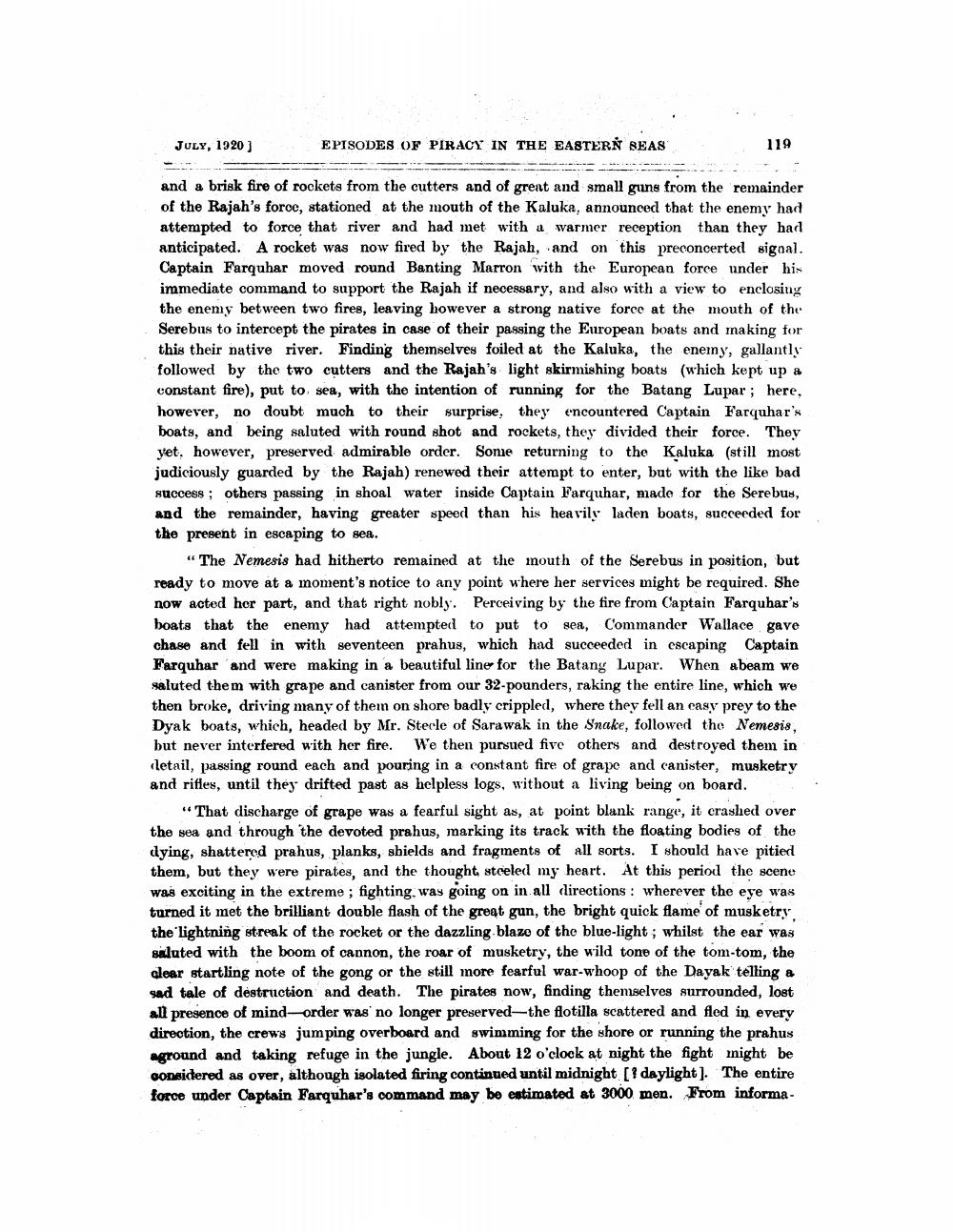________________
EPISODES OF PIRACY IN THE EASTERN SEAS
and a brisk fire of rockets from the cutters and of great and small guns from the remainder of the Rajah's force, stationed at the mouth of the Kaluka, announced that the enemy had attempted to force that river and had met with a warmer reception than they had anticipated. A rocket was now fired by the Rajah, and on this preconcerted signal. Captain Farquhar moved round Banting Marron with the European force under his immediate command to support the Rajah if necessary, and also with a view to enclosing the enemy between two fires, leaving however a strong native force at the mouth of the Serebus to intercept the pirates in case of their passing the European boats and making for this their native river. Finding themselves foiled at the Kaluka, the enemy, gallantly followed by the two cutters and the Rajah's light skirmishing boats (which kept up a constant fire), put to sea, with the intention of running for the Batang Lupar; here, however, no doubt much to their surprise, they encountered Captain Farquhar's boats, and being saluted with round shot and rockets, they divided their force. They yet, however, preserved admirable order. Some returning to the Kaluka (still most judiciously guarded by the Rajah) renewed their attempt to enter, but with the like bad success; others passing in shoal water inside Captain Farquhar, made for the Serebus, and the remainder, having greater speed than his heavily laden boats, succeeded for the present in escaping to sea.
JULY, 1920]
119
"The Nemesis had hitherto remained at the mouth of the Serebus in position, but ready to move at a moment's notice to any point where her services might be required. She now acted her part, and that right nobly. Perceiving by the fire from Captain Farquhar's boats that the enemy had attempted to put to sea, Commander Wallace gave chase and fell in with seventeen prahus, which had succeeded in escaping Captain Farquhar and were making in a beautiful line for the Batang Lupar. When abeam we saluted them with grape and canister from our 32-pounders, raking the entire line, which we then broke, driving many of them on shore badly crippled, where they fell an easy prey to the Dyak boats, which, headed by Mr. Stecle of Sarawak in the Snake, followed the Nemesis, but never interfered with her fire. We then pursued five others and destroyed them in detail, passing round each and pouring in a constant fire of grape and canister, musketry and rifles, until they drifted past as helpless logs, without a living being on board.
"That discharge of grape was a fearful sight as, at point blank range, it crashed over the sea and through the devoted prahus, marking its track with the floating bodies of the dying, shattered prahus, planks, shields and fragments of all sorts. I should have pitied them, but they were pirates, and the thought, steeled my heart. At this period the scene was exciting in the extreme; fighting, was going on in all directions: wherever the eye was turned it met the brilliant double flash of the great gun, the bright quick flame of musketry the lightning streak of the rocket or the dazzling blaze of the blue-light; whilst the ear was saluted with the boom of cannon, the roar of musketry, the wild tone of the tom-tom, the clear startling note of the gong or the still more fearful war-whoop of the Dayak telling a sad tale of destruction and death. The pirates now, finding themselves surrounded, lost all presence of mind-order was no longer preserved the flotilla scattered and fled in every direction, the crews jumping overboard and swimming for the shore or running the prahus aground and taking refuge in the jungle. About 12 o'clock at night the fight might be considered as over, although isolated firing continued until midnight [? daylight]. The entire force under Captain Farquhar's command may be estimated at 3000 men. From informa




